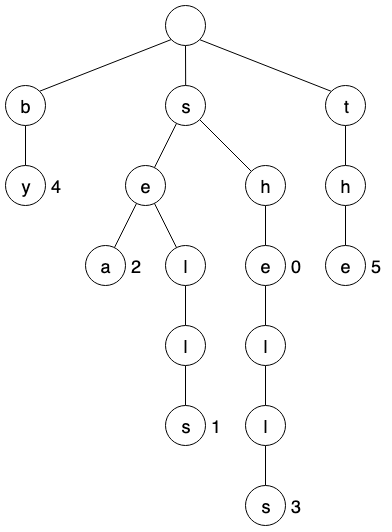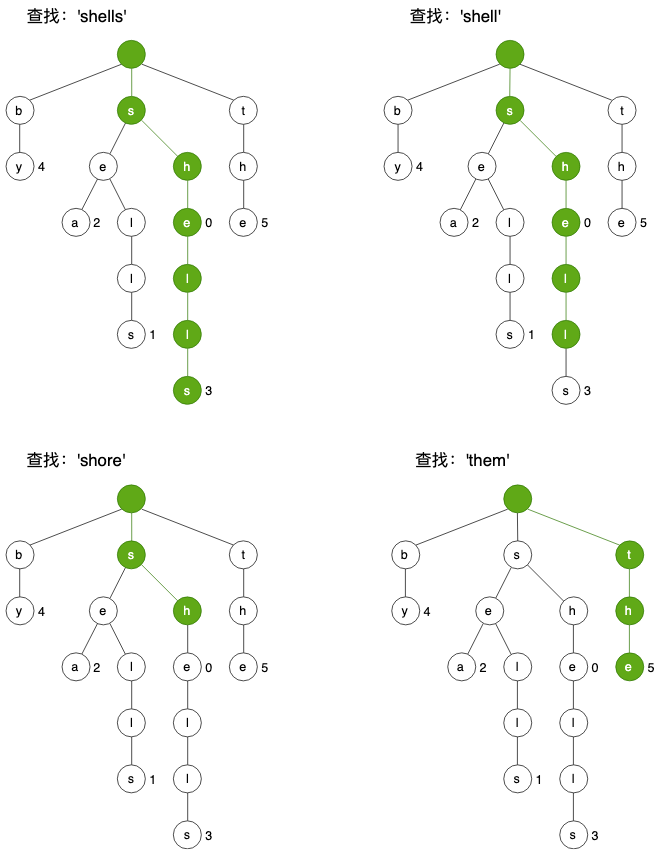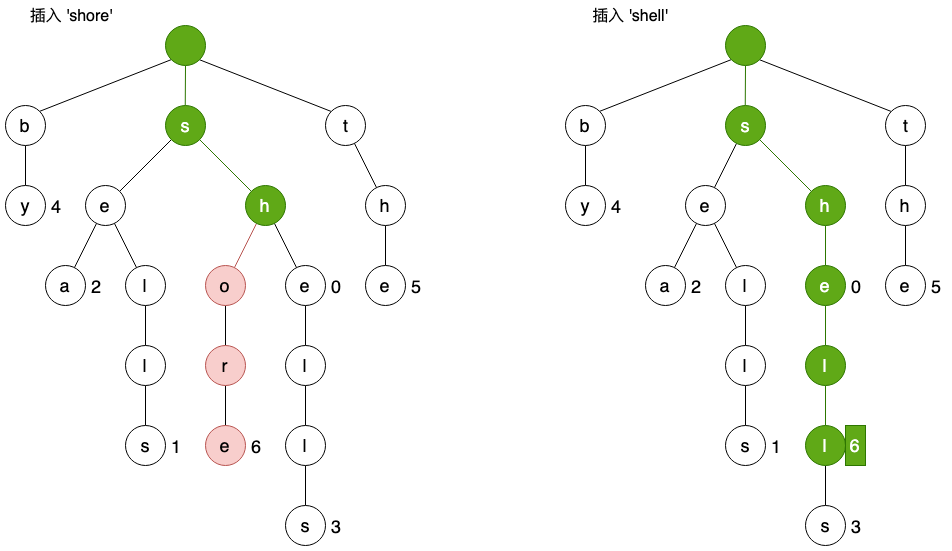平时在进行上网搜索时,都会有搜索提示功能,能够根据我们输入,自动的给出相应的提示内容,那么这个功能应该如何来实现呢,当搜索词库数据量很少时,采用什么办法效率上可能差别不大,但是随着词库的不断增长,查询效率就是我们需要考虑的问题了,单词查找树就是这么一种解决方案。
单词树的表示
比如现在我们希望实现一个查找单词的 App,下面看下如何使用单词查找树来实现,首先要解决的问题就是单词存储,单词查找树,顾名思义,就是用树来保存单词的信息,下图展示一个单词查找树:

上图中,使用单词树存储了如下的单词(这里我们称之为’键’):
| 键 | 值 |
|---|---|
| by | 4 |
| sea | 2 |
| sells | 1 |
| she | 0 |
| shells | 3 |
| the | 5 |
通过观察上面的单词树,可以发现一些特点:
- 链接各个字符结点组成单词;
- 单词的最后一个字符结点记录着单词的值;
- 每个字符结点只有一个父节点,可以保护多个子节点。
这些特点和之前见过的一些树差不多,明显不同的是一些结点会记录对应单词的值,这个值是什么含义,怎么计算的?带着疑问继续下面的学习。
单词树的查找操作
如何在单词树种进行查找,流程其实非常简单,比如在上面树种查找单词“shells”:
- 从根节点出发,在其子节点中查找第一个字符’s’;
- 找到’s’对应的结点之后,在其子节点中继续查找第2个字符’h’,如此递归,直到找到最后一个字符对应结点,或者子节点中不存在对应的字符链接,这里可能会遇到3中情况:
- 尾字符对应结点的值非空,比如查找’shells’、‘she’;
- 尾字符对应结点的值为空,比如查找’shell’;
- 在子节点中没有找到对应字符链接,比如查找’shore’、‘them’。

单词树的插入操作
在向单词树中插入新单词时,为了确定各个字符的插入位置,需要进行先查找,查找时可能遇到2种情况:
- 在子节点中没找到字符的链接,比如插入‘shore’、‘them’;
- 找到了尾字符对应的节点,比如插入‘shell’。

单词树的删除操作
从单词树中删除单词时,首先需要查找单词所对应的尾节点,这里有以下几种情况:
- 未找到单词所对应的尾结点,直接返回;
- 找到单词所对应的尾结点,然后置空该结点的值,下面处理方法分2中情况:
- 该尾结点没有子结点,删除该结点,继续尝试删除父节点;
- 该尾结点包含子结点,直接返回。
单词树的前缀匹配查找操作
在进行搜索提示时,需要查找指定前缀的词,这个过程和单词树的查找比较类似,这里直接上代码:
1 | using System; |
性能
- 时间复杂度:在单词树中查找对应键的值,最坏情况下的时间复杂度为键长度加1;
- 空间复杂度:对于字母表大小为 R、包含 N 个随机键的单词树,键的平均长度为 W,结点的链接总数在 RN ~ RNW 之间,所以有如下规律:
- 当所有键均较短时,链接总数接近于 RN;
- 当所有键均较长时,链接总数接近于 RNW;
- 空间复杂度与 R 大小紧密相关。
总结
上面介绍了单词树 Trie,该数据结构常用来解决从大量词库中查找指定前缀的单词,比如网站的搜索功能,它能够最多搜索次数等于前缀的长度,是一种非常高效的结构,其比较适合键长较短的情景,当键长比较大时,占用的空间将会比较大。
除了上面的介绍的单词树之外,还有三向单词树,与Trie 不同,它是的每个结点只有三个子结点,在键比较长或者字符集比较大时,空间复杂度要比 Trie 树低很多,更加适合 Unicode 字符集。